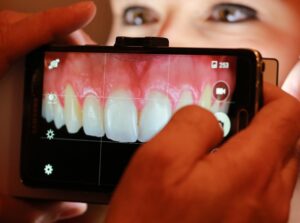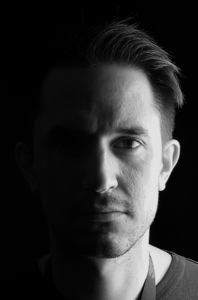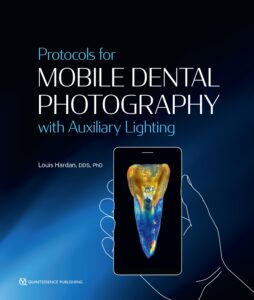Written by: Leah Huffman
Clinical photography can be an intimidating thing for a dentist. Everyone knows you need to document your cases, but do you need to invest in an expensive professional camera setup and learn all the ins and outs to achieve the level of quality you need? Absolutely not. Dr Louis Hardan has an alternative that is easier, cheaper, and certainly more convenient.
After all, with good lighting, a smartphone camera is perfectly able and sufficient to take a good-quality photograph.
In 2012 he started the Mobile Dental Photography (MDP) project in hopes of finding a way to make documentation and communication easy and affordable to all dentists and laboratory technicians, including students. Partnering with Smile Line, he created a lighting device that can be attached to your smartphone camera to ensure good-quality photographs. Dr Hardan recognized that many dentists were already using their smartphone cameras anyway, so why not turn that very capable device into a full studio for excellent photography? After all, with good lighting, a smartphone camera is perfectly able and sufficient to take a good-quality photograph. As Dr Hardan explains it, “Since smartphone cameras are so popular and evolving very quickly during the last few years…I decided to offer a practical, affordable, and easy solution to dentists by developing MDP.” And thus the Smile Lite MDP device was born.

“In truth, we make a good image; we don’t take it.”—Louis Hardan
However, Dr Hardan recognizes that you can’t just slap the Smile Lite on a phone and start taking excellent photographs. First you need to understand how to take clinical photographs properly and how the smartphone camera works. He explains that “In truth, we make a good image; we don’t take it.” So before clinicians can start making good images, they need to understand the basics, which is why he wrote his recent book, Protocols for Mobile Dental Photography with Auxiliary Lighting, to be released in October 2020.
In this book he outlines how to use the smartphone camera with auxiliary lighting and accessories to take photographs for treatment planning, documentation and self-evaluation, communication with the patient and laboratory technician, tracking the evolution of treatment, as well as for publishing, lecturing, and insurance and medicolegal purposes. He also shows how to take artistic photographs to wow your followers on social media and effectively market your practice online.
 Dr Hardan wants dentists to be excited about MDP for its many advantages: “Every dentist has a free camera in his pocket with high performance. Since photography is a good management of light, MDP will offer to the dentist a mini studio where he has all kinds of light used in professional photography, from the ring flash and lateral flashes to diffused and polarized light. Since the light is continuous, the user can see on his screen the final result before taking the picture.” Better yet is that this system costs way less than a professional-grade DSLR camera and is way more intuitive to use.
Dr Hardan wants dentists to be excited about MDP for its many advantages: “Every dentist has a free camera in his pocket with high performance. Since photography is a good management of light, MDP will offer to the dentist a mini studio where he has all kinds of light used in professional photography, from the ring flash and lateral flashes to diffused and polarized light. Since the light is continuous, the user can see on his screen the final result before taking the picture.” Better yet is that this system costs way less than a professional-grade DSLR camera and is way more intuitive to use.
“Every dentist has a free camera in his pocket with high performance. Since photography is a good management of light, MDP will offer to the dentist a mini studio where he has all kinds of light used in professional photography.”—Louis Hardan
 One of the coolest things about MDP is that you can use it to take artistic photographs like half-illuminated portraits, birefringence photographs, and glam shots of lips and teeth. Dr Hardan shows in his book how to take all of these with your smartphone. Social media has quickly become an effective marketing tool for dentists, and shots like these can give you the edge you need to succeed. As Dr Hardan underscores, “Lots of pictures on social media are low quality because of the lighting used. High-quality photographs with MDP can be used to market our work. If the dental treatment is perfect but the pictures are bad in quality, the marketing message will be very bad. That is why the dental pictures should be perfect, and by adding artistic pictures, the impact on social media will be very high.”
One of the coolest things about MDP is that you can use it to take artistic photographs like half-illuminated portraits, birefringence photographs, and glam shots of lips and teeth. Dr Hardan shows in his book how to take all of these with your smartphone. Social media has quickly become an effective marketing tool for dentists, and shots like these can give you the edge you need to succeed. As Dr Hardan underscores, “Lots of pictures on social media are low quality because of the lighting used. High-quality photographs with MDP can be used to market our work. If the dental treatment is perfect but the pictures are bad in quality, the marketing message will be very bad. That is why the dental pictures should be perfect, and by adding artistic pictures, the impact on social media will be very high.”

If you’re already using a DSLR system you love, don’t change a thing. But if you’re struggling with your existing system, aren’t taking the types of images you’d like to, or simply aren’t taking any images at all, consider what MDP can do for you and your practice. Dr Hardan sums it up like this: “MDP in daily use is very practical, easy, lightweight, can be disinfected, and helps to take all kinds of photographs.” You simply cannot go wrong with MDP for clinical photography.
To preview Dr Hardan’s new book, click here.
 Protocols for Mobile Dental Photography with Auxiliary Lighting
Protocols for Mobile Dental Photography with Auxiliary Lighting
Louis Hardan
Billions of photographs are taken worldwide each day, and most of them are captured with a smartphone. In the context of clinical dentistry, many clinicians use their smartphone to take clinical photographs for communication or documentation simply because they cannot operate or afford a professional camera. Author Louis Hardan understands too well how a poorly taken photograph can compromise the quality of dentistry delivered to the patient, which is why he launched the Mobile Dental Photography (MDP) project in 2012. He wanted to find a way to make documentation and communication easy and affordable to all dentists and laboratory technicians, including students. In this book he outlines how to use the smartphone camera with auxiliary lighting and accessories to take photographs for treatment planning, documentation and self-evaluation, communication with the patient and laboratory technician, tracking the evolution of treatment, as well as for publishing, lecturing, and insurance and medicolegal purposes. He also shows how to take artistic photographs to wow your followers on social media and effectively market your practice online. You really can get similar-quality images with a smartphone camera as with a DSLR camera; you just need to know how to use it. This book is the key.
128 pp; 315 illus; ISBN 978-0-86715-946-2 (B9462); US $75
